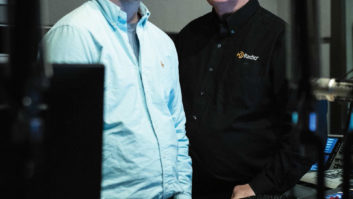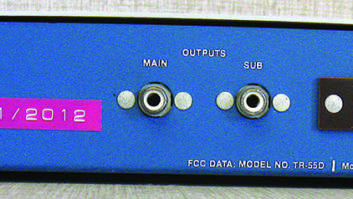I’ve only worked with one engineer, now many years retired, who made soldered RCA plugs a work of art. As widely used as these plugs are, they are without a doubt the most cantankerous. The insulation melts on the center conductor wire, many times shorting it out when you screw on the barrel shell. And if you don’t get the center pin hot enough, you’ll end up with an intermittent cold solder joint.
The list goes on. How these plugs gained such popularity in our industry amazes me.
If you have tips on how to handle RCA plugs, send them in, we may learn something.
(click thumbnail)Fig. 1: Bomar’s crimp-on RCA plug ends the frustration in terminating wires in this type of connector.
Retired RKO Washington CE Henry “Chic” Leyh taught me how to solder these plugs without melting the conductors. “Patience is a virtue” certainly applies to soldering RCA plugs.
For RF applications, there is a better way.
Bomar Interconnect Products has released an RCA crimp-on plug that couples signal integrity with efficient installation. Shown in Fig. 1, this addition to the company’s specialty connectors is constructed of precision-machined brass, with heavy nickel plating.
The corrosion-resistant interconnects feature gold-plated, semi-captive contacts for durable connections. Shielding technology provides isolation from EMI and RFI interference. A crimp tool is available optionally.
Prices for Bomar’s RCA Crimp-On Plugs start at $1.49 each in quantities of 1,000. Delivery is from stock to eight weeks. Bomar is located in Ledgewood, N.J. Reach them at www.bomarinterconnect.com or by telephone, (973) 347-4040.
Let them know you heard about their product in the pages of Radio World.

. . .
Louis Bornwasser practices broadcast engineering in Kentucky. He writes (with a grin, I’m sure) that he’s old enough to have a First Phone. For the uninitiated, this is the FCC First Class License once required of every broadcast engineer.
Louis wrote to us about a Collins transmitter that used two 10 kW finals driven by a 1 kW driver. One of the problems using this rig was what to do with the excessive driver power when operating with only one 10 kW final.
Louis solved this problem with a “three-way” switch on the plate transformer. Feeding 120 volts to the 220-volt transformer lowered the output to the exact amount now required. With plenty of these old rigs still in operation, Louis’ modification just might help.
Louis weighed in on our parts ordering discussion. He too orders two parts when one fails, to help build up a spares kit. However, if any part fails a second time, in short order, he’ll order enough to carry two spares.
. . .
(click thumbnail)Fig. 2: Dirt inside the heat transfer fins of a compressor/evaporator can impair air-conditioning efficiency.
It won’t be long before the summer heat really taxes your transmitter – and studio – air conditioning. Fig. 2 shows some of the dirt inside the heat transfer fins of this compressor/evaporator, located outside the building. A high-pressure washing of the coils will improve the air conditioner’s efficiency. The maintenance is cost-effective when you consider the replacement cost.
I’ve had several engineers report that they’ve obtained reasonable package deals from HVAC contractors to clean the condensers at several transmitter sites, as recommended in a previous column. Don’t heap this kind of maintenance onto your plate; pass it on to a contractor. Concerned about cost? See if your sales manager can work out a trade.

. . .
We’ve had two engineers write about problems with rebuilt tubes. Here’s another point of view from Carl Campbell, chief engineer for Salem Music Network.
“I’m perplexed after reading these two accounts. Does anyone know why the rebuilt tubes behaved this way? I remember that Winston Hawkin’s situation involved a CCA transmitter. Is there something about the CCA that makes it incompatible with rebuilds?”
Good question. I’ve known lots of engineers who used rebuilds in all types of transmitters, most with good results. Carl writes that he was responsible for a pair of Harris FM20Ks 16 years ago. He used rebuilds for this transmitter, but remembers that when shipping in the dud for rebuilding, you had to declare which model of transmitter you were using.
It turns out there was a difference in the grid circuit that varied between models. The variation required a different tolerance inside the tube.
As for today’s rebuilds, Carl can’t remember the last time he installed a brand-new Eimac, because of the cost disparity. He’s always gotten good service from the rebuilds.
(click thumbnail)Fig. 3: Inspect transmitter building doors for water damage.
What’s your experience? Any tips to ensure better use of rebuilds? Send them to me at [email protected].

. . .
Parts of the country had a pretty rough winter, with lots of snow and rain. Result? Moisture that can attack your transmitter building.
That’s not a shadow along the threshold of the door in Fig. 3; water has leaked under the threshold and into the building. Not around the transmitter building when it rains? Pour a thin line of colored powdered chalk – sold at hardware and lumber companies – along the threshold, inside the building. If water enters, it will smear the chalk line.
Usually, a bead of caulk along the outside of the threshold will control the problem. Otherwise, grade the earth away from the building.
Submissions for this column are encouraged and qualify for SBE recertification credit.







